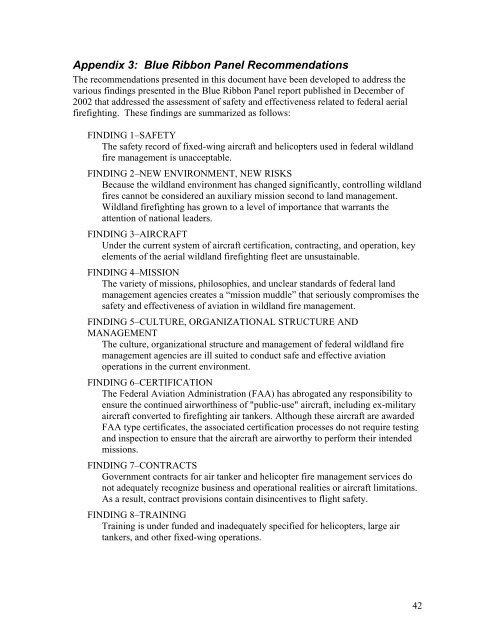Interagency Aviation Strategy - July 2008 - National Wildfire ...
Interagency Aviation Strategy - July 2008 - National Wildfire ...
Interagency Aviation Strategy - July 2008 - National Wildfire ...
You also want an ePaper? Increase the reach of your titles
YUMPU automatically turns print PDFs into web optimized ePapers that Google loves.
Appendix 3: Blue Ribbon Panel Recommendations<br />
The recommendations presented in this document have been developed to address the<br />
various findings presented in the Blue Ribbon Panel report published in December of<br />
2002 that addressed the assessment of safety and effectiveness related to federal aerial<br />
firefighting. These findings are summarized as follows:<br />
FINDING 1–SAFETY<br />
The safety record of fixed-wing aircraft and helicopters used in federal wildland<br />
fire management is unacceptable.<br />
FINDING 2–NEW ENVIRONMENT, NEW RISKS<br />
Because the wildland environment has changed significantly, controlling wildland<br />
fires cannot be considered an auxiliary mission second to land management.<br />
Wildland firefighting has grown to a level of importance that warrants the<br />
attention of national leaders.<br />
FINDING 3–AIRCRAFT<br />
Under the current system of aircraft certification, contracting, and operation, key<br />
elements of the aerial wildland firefighting fleet are unsustainable.<br />
FINDING 4–MISSION<br />
The variety of missions, philosophies, and unclear standards of federal land<br />
management agencies creates a “mission muddle” that seriously compromises the<br />
safety and effectiveness of aviation in wildland fire management.<br />
FINDING 5–CULTURE, ORGANIZATIONAL STRUCTURE AND<br />
MANAGEMENT<br />
The culture, organizational structure and management of federal wildland fire<br />
management agencies are ill suited to conduct safe and effective aviation<br />
operations in the current environment.<br />
FINDING 6–CERTIFICATION<br />
The Federal <strong>Aviation</strong> Administration (FAA) has abrogated any responsibility to<br />
ensure the continued airworthiness of "public-use" aircraft, including ex-military<br />
aircraft converted to firefighting air tankers. Although these aircraft are awarded<br />
FAA type certificates, the associated certification processes do not require testing<br />
and inspection to ensure that the aircraft are airworthy to perform their intended<br />
missions.<br />
FINDING 7–CONTRACTS<br />
Government contracts for air tanker and helicopter fire management services do<br />
not adequately recognize business and operational realities or aircraft limitations.<br />
As a result, contract provisions contain disincentives to flight safety.<br />
FINDING 8–TRAINING<br />
Training is under funded and inadequately specified for helicopters, large air<br />
tankers, and other fixed-wing operations.<br />
42
















